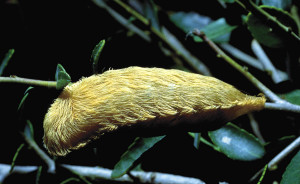I’ve been hearing reports of people being stung by asps (puss caterpillars). The larva is the problematic stage for this insect as the caterpillars often fall out of trees and land on unsuspecting people below. When this happens, the person may get stung.

Image from hortipm.tamu.edu
The caterpillar has venomous spines which can cause a varying reaction. There are some people who react more severely to the toxin than others. The severity of the sting can also depend upon the thickness of the skin where the sting occurs. Often stings will cause localized burning and redness (usually in the shape of the caterpillar) sometimes paired with swelling. More severe reactions may cause fever, headache, nausea, vomiting and other symptoms. If you are stung by a caterpillar and are concerned with your symptoms, seek medical attention.
Smaller instars are yellow in color while later instars turn pale green to white. The spines containing venom are concealed in later instars by long, soft-looking setae (hairs).
Asps are known to feed on foliage of over 40 genera of plants. They will often wander to nearby plants when they are preparing to pupate.
If you have large populations of these caterpillars and would like to manage them, you can try Bacillus thuringiensis var. kurstaki (this targets caterpillars only, but will also kill “good” caterpillars). You may also look for active ingredients such as spinosad or azadirachtin (both naturally-derived products). These products tend to work best on smaller instars. Another option would be a residual pesticide labeled for caterpillars that is okay to use on plants.